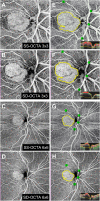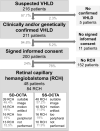Comparison of Current Optical Coherence Tomography Angiography Methods in Imaging Retinal Hemangioblastomas
- PMID: 32855859
- PMCID: PMC7422766
- DOI: 10.1167/tvst.9.8.12
Comparison of Current Optical Coherence Tomography Angiography Methods in Imaging Retinal Hemangioblastomas
Abstract
Purpose: To compare spectral-domain (SD) and swept-source (SS) optical coherence tomography angiography (OCTA) for imaging retinal capillary hemangioblastomas (RCHs) in von Hippel-Lindau disease (VHLD).
Methods: Prospective single-center cross-sectional study. Tumor size (TS) of perfused RCHs was assessed clinically in relation to the optic disc size. For both technologies, SD-OCTA and SS-OCTA, corresponding images with a scan size of 3 × 3 mm2 and 6 × 6 mm2, respectively, were overlaid according to the set of marker positions to determine the TS.
Results: From 200 patients with VHLD, 48 patients showed 84 RCHs. SD-OCTA images of 39 RCHs (46.4%) and SS-OCTA images of 48 RCHs (57.2%) were suitable for analysis. The average in OCTA-measured TS of 1.60 ± 2.58 mm2 (range, 0.01-10.43) was congruent to the clinically assessed TS in 81.3% of cases (r = 0.86, P < 0.0001). TS measured in SD-OCTA compared to SS-OCTA showed similar values and a high correlation (all P < 0.0001). Nevertheless, despite the similarities, a slight trend in SS-OCTA was observed whereby with increasing TS, an elevated TS was detected compared to SD-OCTA (3 × 3-mm2 scans: mean difference of 0.03 ± 0.04 mm2, 6 × 6-mm2 scans: 0.08 ± 0.19 mm2). However, within the same imaging technology method, TS values almost did not differ (SD-OCTA: mean difference of 0.01 ± 0.02 mm2, SS-OCTA: 0.001 ± 0.01 mm2).
Conclusions: OCTA may serve as an additional tool for diagnosis and monitoring of RCHs. Nevertheless, due to the differences between the technologies, the values cannot be used interchangeably.
Translational relevance: SD-OCTA and SS-OCTA are suitable to detect and monitor RCHs and provide a more detailed assessment about the TS than this is clinically possible.
Keywords: OCT angiography; retinal capillary hemangioblastoma; spectral domain optical coherence tomography angiography; swept-source optical coherence tomography angiography; von Hippel-Lindau disease.
Copyright 2020 The Authors.
Conflict of interest statement
Disclosure: M. Reich, None; A. Glatz, None; D. Boehringer, None; C. Evers, None; M. Daniel, None; F. Bucher, None; F. Ludwig, None; S. Nuessle, None; W.A. Lagrèze, None; P.M. Maloca, None; C. Lange, None; T. Reinhard, None; H. Agostini, None; S.J. Lang, None
Figures




Similar articles
-
Combined therapy guided by multimodal imaging of fifteen retinal capillary hemangioblastomas in a monocular Von Hippel- Lindau syndrome case report.BMC Ophthalmol. 2022 May 6;22(1):205. doi: 10.1186/s12886-022-02409-8. BMC Ophthalmol. 2022. PMID: 35524216 Free PMC article.
-
Comparison Between Spectral-Domain and Swept-Source Optical Coherence Tomography Angiographic Imaging of Choroidal Neovascularization.Invest Ophthalmol Vis Sci. 2017 Mar 1;58(3):1499-1505. doi: 10.1167/iovs.16-20969. Invest Ophthalmol Vis Sci. 2017. PMID: 28273316 Free PMC article.
-
Comparison of optical coherence tomography angiography and fundus fluorescein angiography features of retinal capillary hemangioblastoma.Indian J Ophthalmol. 2018 Jun;66(6):872-876. doi: 10.4103/ijo.IJO_1199_17. Indian J Ophthalmol. 2018. PMID: 29786009 Free PMC article.
-
Retinal applications of swept source optical coherence tomography (OCT) and optical coherence tomography angiography (OCTA).Prog Retin Eye Res. 2021 Sep;84:100951. doi: 10.1016/j.preteyeres.2021.100951. Epub 2021 Jan 28. Prog Retin Eye Res. 2021. PMID: 33516833 Review.
-
Optical Coherence Tomography Angiography in Glaucoma Care.Curr Eye Res. 2018 Sep;43(9):1067-1082. doi: 10.1080/02713683.2018.1475013. Epub 2018 May 23. Curr Eye Res. 2018. PMID: 29757019 Review.
Cited by
-
Combined therapy guided by multimodal imaging of fifteen retinal capillary hemangioblastomas in a monocular Von Hippel- Lindau syndrome case report.BMC Ophthalmol. 2022 May 6;22(1):205. doi: 10.1186/s12886-022-02409-8. BMC Ophthalmol. 2022. PMID: 35524216 Free PMC article.
-
Optical Coherence Tomography Angiography-Navigated Laser Photocoagulation of Retinal Hemangioblastomas in Patients With von Hippel-Lindau Disease.Transl Vis Sci Technol. 2024 Jul 1;13(7):8. doi: 10.1167/tvst.13.7.8. Transl Vis Sci Technol. 2024. PMID: 38980260 Free PMC article.
-
Role of optical coherence tomography angiography in retinal tumors: A narrative review.Indian J Ophthalmol. 2024 Aug 1;72(8):1082-1090. doi: 10.4103/IJO.IJO_29_24. Epub 2024 Jul 29. Indian J Ophthalmol. 2024. PMID: 39078951 Free PMC article. Review.
-
Imaging features of retinal hemangioblastoma: A case report.World J Clin Cases. 2023 Jan 26;11(3):692-699. doi: 10.12998/wjcc.v11.i3.692. World J Clin Cases. 2023. PMID: 36793647 Free PMC article.
-
ZEISS PLEX Elite 9000 Widefield Optical Coherence Tomography Angiography as Screening Method for Early Detection of Retinal Hemangioblastomas in von Hippel-Lindau Disease.Transl Vis Sci Technol. 2024 Feb 1;13(2):8. doi: 10.1167/tvst.13.2.8. Transl Vis Sci Technol. 2024. PMID: 38345551 Free PMC article.
References
-
- Koustenis A Jr, Harris A, Gross J, Januleviciene I, Shah A, Siesky B. Optical coherence tomography angiography: an overview of the technology and an assessment of applications for clinical research. Br J Ophthalmol. 2017; 101: 16–20. - PubMed
-
- Ferrara D, Waheed NK, Duker JS. Investigating the choriocapillaris and choroidal vasculature with new optical coherence tomography technologies. Prog Retin Eye Res. 2016; 52: 130–155. - PubMed
Publication types
MeSH terms
LinkOut - more resources
Full Text Sources

